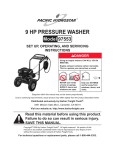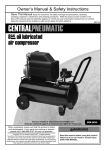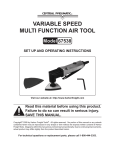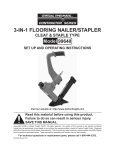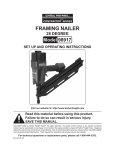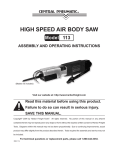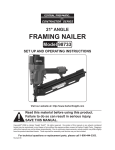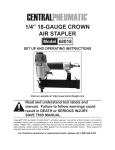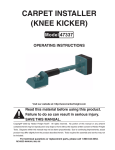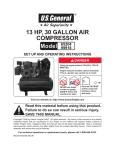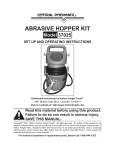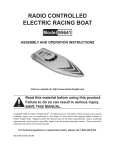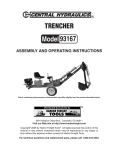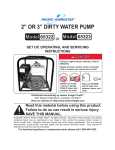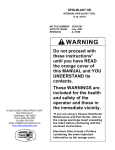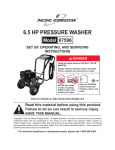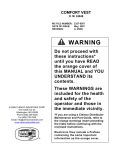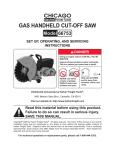Download 9 HP ride-on trencHer - Harbor Freight Tools
Transcript
9 HP ride-on trencher Model 65162 Set up, Operating, and Servicing Instructions WARNING! IMPORTANT INFORMATION The Hitch Coupler MUST be properly secured to the hitch ball of the towing vehicle. After assembly and attachment, pull up and down on the Hitch Coupler to make sure the hitch ball is fitting snugly in the Hitch Coupler. There must be no play between the hitch ball and Hitch Coupler. If there is play, tighten the Adjustment Nut until no play is present. If the Adjustment Nut is too tight, the Handle will not lock. Carefully read and follow the complete instructions in this manual BEFORE setup or use. If the Coupler is not secured properly, the ball could come loose while the Log Splitter is in motion, possibly causing property damage, serious personal injury, or death. Visit our website at: http://www.harborfreight.com Read this material before using this product. Failure to do so can result in serious injury. Save this manual. Copyright© 2008 by Harbor Freight Tools®. All rights reserved. No portion of this manual or any artwork contained herein may be reproduced in any shape or form without the express written consent of Harbor Freight Tools. Diagrams within this manual may not be drawn proportionally. Due to continuing improvements, actual product may differ slightly from the product described herein. Tools required for assembly and service may not be included. For technical questions or replacement parts, please call 1-800-444-3353. Revised 11a Contents Important SAFETY Information���������������������������� 4 SET UP PRECAUTIONS�������������������� 4 OPERATING PRECAUTIONS������������ 5 Service precautions������������� 6 Refueling:��������������������������������� 7 Trencher precautions�������� 7 Basic Specifications������������� 8 Unpacking���������������������������������� 8 Set Up Instructions��������������� 8 Cleaning, Maintenance, and Lubrication Schedule���������� 21 After 20 Operation Hour Break-in Period:���������������� 21 After Every 25 Operation Hours:������������������������������������ 21 After Every 50 Operation Hours:������������������������������������ 21 After Every 100 Operation Hours:�������������� 21 After Every 300 Operation Hours:�������������� 21 Periodically:������������������������� 21 Storage����������������������������������������21 Lubrication Points������������������� 22 Assembly���������������������������������������� 8 Troubleshooting���������������������� 23 Attaching the Leg Assembly10 Parts List��������������������������������� 25 Purging the Cylinder�������������� 12 General Assembly diagram���������������������������������� 26 Operating Instructions���� 12 Starting the Engine����������������� 12 Checking Engine Oil Level12 Cylinder head parts list & diagram������������������������������ 27 Engine diagram���������������������� 13 Crank case parts list & Checking Fuel Level����������� 14 diagram���������������������������������� 28 Break-in Period�������������������� 14 Equipment Operation��������������� 15 Moving the Trencher��������� 16 Transporting the Trencher������������������������������ 17 Technical Specifications�� 19 Crank case cover parts list and diagram����������������� 29 CRANKSHAFT/PISTON PARTS LIST & DIAGRAM���������������������� 30 Gas distribution Servicing���������������������������������� 19 adjustment system parts list & diagram��������� 31 Maintenance Procedures����� 19 Engine Oil Change��������������� 19 Air Filter Element Maintenance����������������������� 19 Spark Plug Maintenance�� 20 Fuel Filter Replacement (if equipped)������������������������� 20 SKU 65162 Starter subassembly parts list & diagram��������� 32 Diversion Assembly parts list & diagram���������������������� 33 For technical questions, please call 1-800-444-3353. Page 2 Carburetor parts list & diagram���������������������������������� 34 Flywheel/coil assembly parts list & diagram��������� 35 Control system parts list & diagram���������������������� 36 Air cleaner parts list & diagram���������������������������������� 37 Muffler parts list & diagram���������������������������������� 38 Fuel tank parts list & diagram���������������������������������� 39 Limited 1 year / 90 Day warranty������������������������������ 40 Emission Control System Warranty������������������������������ 40 SKU 65162 For technical questions, please call 1-800-444-3353. Page 3 Save This Manual Notice NOTICE is used to address practices not related to personal injury. Keep this manual for the safety warnings and precautions, assembly, operating, inspection, maintenance and cleaning procedures. Write the product’s serial number in the back of the manual near the assembly diagram (or month and year of purchase if product has no number). Keep this manual and the receipt in a safe and dry place for future reference. Caution CAUTION, without the safety alert symbol, is used to address practices not related to personal injury. WARNING! Read all instructions. Failure to follow all instructions listed below may result in fire, serious injury and/or DEATH. The warnings and precautions discussed in this manual cannot cover all possible conditions and situations that may occur. It must be understood by the operator that common sense and caution are factors which cannot be built into this product, but must be supplied by the operator. Important SAFETY Information In this manual, on the labeling, and all other information provided with this product: This is the safety alert symbol. It is used to alert you to potential personal injury hazards. Obey all safety messages that follow this symbol to avoid possible injury or death. DANGER indicates a hazardous situation which, if not avoided, will result in death or serious injury. SAVE THESE INSTRUCTIONS SET UP PRECAUTIONS 1. Gasoline fuel and fumes are flammable, and potentially explosive. Use proper fuel storage and handling procedures. Do not store fuel or other flammable materials nearby. 2. Have multiple ABC class fire extinguishers nearby. 3. This equipment has a spark arresting muffler included. A spark arresting muffler is required by law in California, on some US Forest Service land, and possibly in other areas or situations. 4. Set up and use only on a flat, level, well-ventilated surface. Danger WARNING indicates a hazardous situation which, if not avoided, could result in death or serious injury. WARNING CAUTION, used with the safety alert symbol, indicates a hazardous situation which, if not avoided, could result in minor or moderate injury. Caution SKU 65162 For technical questions, please call 1-800-444-3353. Page 4 5. Wear ANSI-approved safety goggles, heavy-duty work gloves, and dust mask/respirator during set up and use. 6. Use only oil and fuel recommended in the “Specifications” section of this manual. Tools for your model. Accessories that may be suitable for one piece of equipment may become hazardous when used on another piece of equipment. 7. Stay alert, watch what you are doing and use common sense when operating a piece of equipment. Do not use a piece of equipment while tired or under the influence of drugs, alcohol or medication. 8. Do not overreach. Keep proper balance at all times. This enables better control of the equipment in unexpected situations. 9. Dress properly. Do not wear loose clothing or jewelry. Keep hair, clothing and gloves away from moving parts. Loose clothes, jewelry or long hair can be caught in moving parts. OPERATING PRECAUTIONS 1. Carbon Monoxide Hazard Using an engine indoors CAN KILL YOU IN MINUTES. Engine exhaust contains carbon monoxide. This is a poison you cannot see or smell. NEVER use inside a home or garage, EVEN IF doors and windows are open. Only use OUTSIDE and far away from windows, doors, and vents. 10. Parts of the equipment, especially exhaust system components, get very hot during use. Stay clear of hot parts. 2. Keep children and observers 20 feet away from the equipment while it is operating. 3. Do not leave the equipment unattended when it is running. Turn off the equipment (and remove safety keys, if available) before leaving the work area. 11. Do not cover the engine or equipment during operation. 4. Wear ANSI-approved safety goggles and hearing protection during use. 5. People with pacemakers should consult their physician(s) before use. Electromagnetic fields in close proximity to a heart pacemaker could cause pacemaker interference or pacemaker failure. Caution is necessary when near the engine’s magneto or recoil starter. 13. Use the equipment, accessories, etc., in accordance with these instructions and in the manner intended for the particular type of equipment, taking into account the working conditions and the work to be performed. Use of the equipment for operations different from those intended could result in a hazardous situation. 6. Use only accessories that are recommended by Harbor Freight SKU 65162 12. Keep the equipment, engine, and surrounding area clean at all times. 14. Do not operate the equipment with known leaks in the engine’s fuel system. For technical questions, please call 1-800-444-3353. Page 5 15. This product contains or, when used, produces a chemical known to the State of California to cause cancer and birth defects or other reproductive harm. (California Health & Safety Code § 25249.5, et seq.) 16. When spills of fuel or oil occur, they must be cleaned up immediately. Dispose of fluids and cleaning materials as per any local, state, or federal codes and regulations. Store oil rags in a bottom-ventilated, covered, metal container. 17. Keep hands and feet away from moving parts. Do not reach over or across equipment while operating. 18. Before use, check for misalignment or binding of moving parts, breakage of parts, and any other condition that may affect the equipment’s operation. If damaged, have the equipment serviced before use. Many accidents are caused by poorly maintained equipment. 19. Use the correct equipment for the application. Do not modify the equipment and do not use the equipment for a purpose for which it is not intended. guards include muffler, air cleaner, mechanical guards, and heat shields, among other guards. 3. Do not alter or adjust any part of the equipment or its engine that is sealed by the manufacturer or distributor. Only a qualified service technician may adjust parts that may increase or decrease governed engine speed. 4. Wear ANSI-approved safety goggles, heavy-duty work gloves, steel toe work boots, dust mask/respirator and hard hat during use and service. 5. Do not allow the hydraulic hose to come in contact with any hot part of the unit. The hose might be damaged, possibly causing it to burst or leak under high pressure. 6. Maintain labels and nameplates on the equipment. These carry important information. If unreadable or missing, contact Harbor Freight Tools for a replacement. 7. Have the equipment serviced by a qualified repair person using only identical replacement parts. This will ensure that the safety of the equipment is maintained. Do not attempt any service or maintenance procedures not explained in this manual or any procedures that you are uncertain about your ability to perform safely or correctly. 8. Store equipment out of the reach of children. 9. Follow scheduled engine and equipment maintenance. Service precautions 1. Before service, maintenance, or cleaning: a.Turn the engine switch to its “OFF” position. b.Allow the engine to completely cool. c.Then, remove the spark plug wire(s) from the spark plug(s). 2. Keep all safety guards in place and in proper working order. Safety SKU 65162 For technical questions, please call 1-800-444-3353. Page 6 Refueling: 1. Do not smoke, or allow sparks, flames, or other sources of ignition around the equipment, especially when refuelling. 2. Do not refill the fuel tank while the engine is running or hot. 3. Do not fill fuel tank to the top. Leave a little room for the fuel to expand as needed. 4. Refuel in a well-ventilated area only. Trencher precautions 1. Always make sure the hitch coupler is securely fixed to the vehicle before moving it. If the Coupler is not se cured properly, the link could come loose while the trailer is in motion, possibly causing property damage, SERIOUS PERSONAL INJURY, or DEATH. 2. Contact local utility companies before beginning any project. Buried utility lines may not be marked and, if struck, can cause SERIOUS PERSONAL INJURY or DEATH. 3. WARNING: Some dust created by power sanding, sawing, grinding, drilling, and other construction activities, contains chemicals known [to the State of California] to cause cancer, birth defects or other reproductive harm. Some examples of these chemicals are: • Lead from lead-based paints • Crystalline silica from bricks and cement or other masonry products • Arsenic and chromium from chemically treated lumber Your risk from these exposures varies, depending on how often you SKU 65162 do this type of work. To reduce your exposure to these chemicals: work in a well ventilated area, and work with approved safety equipment, such as those dust masks that are specially designed to filter out microscopic particles. (California Health & Safety Code § 25249.5, et seq.) 4. Never place your hands or body near a hydraulic fluid leak. High-pressure fluid can be forced under the skin resulting in serious injury. 5. Do not exceed 30 MPH when towing the Trencher. 6. Do not tow the Trencher on roads or highways. This product is not D.O.T. compliant, and is not road legal. Save these instructions. For technical questions, please call 1-800-444-3353. Page 7 Basic Specifications Fuel Engine Oil Type 86+ octane unleaded gasoline Capacity 1.58 Gallons Type SAE 10W 30 above 32° F 5W30 at 32° F or below Capacity 1.2 Quarts Hydraulic Oil 3.5 Gallons Engine Speed 3,600 RPM Engine Family 6CGP.2702GA Tire Inflation 65 PSI Digging Depth 5-1/2 and 7 Feet Deep Maximum Digging Reach 8 Feet Spool Valve Rated 10.6 G.P.M. Pump Rated 2.7 G.P.M. Boom Travel 60° Left/Right Bucket Load Capacity 1.24 Cubic Feet Hitch Ball size 1-7/8” Diameter Note: Additional specifications found in the Technical Engine Specifications chart in this manual. Harbor Freight Tools at the number shown on the cover of this manual as soon as possible. Set Up Instructions Read the entire Important Safety Information section at the beginning of this manual including all text under subheadings therein before set up or use of this product. Risk of accidental starting; resulting in serious personal injury. Turn the Power Switch of the equipment to its “OFF” position, wait for the engine to cool, and unplug the spark plug wire(s) before assembling or making any adjustments to the equipment. WARNING Note: For additional information regarding the parts listed in the following pages, refer to the Assembly Diagram near the end of this manual. The emission control system for this product’s Engine is warranted for standards set by the U.S. Environmental Protection Agency and by the California Air Resources Board (also known as CARB). For warranty 1. information, refer to the last pages of this manual. At high altitudes, the engine’s carburetor, governor (if so equipped), and any other parts that control the fuel-air ratio will need to 2. be adjusted by a qualified mechanic to allow efficient high-altitude use and to prevent damage to the engine and any other devices used with this product. 3. Unpacking Assembly This equipment has a spark arresting muffler. A spark arresting muffler is required by law in California, on some US Forest Service land, and possibly in other areas or situations. Due to the size of the Trencher and its components, assistance may be required during the entire assembly process. Use jacks (not included) to evenly raise the Frame Assembly (90) & support with jack stands (not included). When unpacking, check to make sure that the item is intact and undamaged. If any parts are missing or broken, please call SKU 65162 For technical questions, please call 1-800-444-3353. REV 09b, 09i Page 8 SKU 65162 For technical questions, please call 1-800-444-3353. Page 9 4. Mount both Axles (50) near the boom end of the frame and secure with Lock Pins (82). 5. Place a Tire (52) over the four studs on each Hub. Secure the Tires to the Hubs, using four Lug Nuts (53) per Tire. The lug nuts must be snug. Inflate the tires to 65 PSI. 6. Slightly raise the Jacks, remove the Jack Stands, then lower the Jacks. Block the tires and tighten the Lug Nuts to at least 90 Ft-Lbs. 7. Attach Seat (73) to the Seat Bottom Plate (10) and secure both Seat and Plate to the post on top of Hydraulic Oil Tank. 8. Attach the Control Support (3) to the Frame Assembly (90) using four Hex Bolts (81). NOTE: The Hydraulics of this unit are tested before shipment. There may be hydraulic fluid present in components. Assemble the unit in an area that will not be damaged by leaking hydraulic fluid. It is recommended that you wrap rags securely over the Hydraulic connectors on all the Cylinders during assembly. Wear splash-resistant ANSI approved safety goggles and other protective gear to prevent injury from leaking fluid. 9. Attach the Main Boom (36) to the Boom Pivot (38) using the Pin (42) through the bottom hole and Clevis Pin No. 1 (29) through the upper hole. Secure both pins with Hair Pin Clip (31); Pin (42) requires one Cotter pin on each end. See photo above right. SKU 65162 Boom Pivot (38) Clevis Pin No. 1 (29) Main Boom (36) Pin (42) 10. Mount the Boom Extension (34) to the Main Boom (36) using the Pin (42), left, and Clevis Pin No. 1 (29), top. Secure both pins with Hair Pin Clip (31). 11. Attach the Hitch Coupler (58) to the Frame Assembly (90) under the Engine (74) using Hex Bolts (75) and Hex HD. Bolt (72). 12. Connect, tighten, and check all hydraulic hose fittings to the proper connections, as shown in the Hose Connection Diagram. Hoses and fittings are numbered. Tighten all fittings. 13. Open the Hydraulic Fluid Fill Plug (11). Top off the Hydraulic Fluid Reservoir with high quality hydraulic fluid. Check that the Fluid level is between the lines on the attached Dipstick. Close the Hydraulic Fluid Fill Plug securely. Attaching the Leg Assembly 1. To use the Trencher, the Leg Assemblies must be installed next to the Boom (36), and the Wheels and Axles (50) moved to the rear. REV 09i For technical questions, please call 1-800-444-3353. Page 10 Hose Connection Diagram Hydraulic Fluid Reservoir part of Frame (90) Hydraulic Pump (65) Control Panel / Spool Valve (9) Main Boom Cylinder Boom Extension Cylinder 5 9 10 3 Boom Swing Cylinder 8 Bucket Control Cylinder 4 2 Clevis Pin No. 1 (29) 7 Pin (42) Hydraulic Fluid Fill Plug (11) Seat (73) Control Panel (9) Engine (74) Boom Extension (34) Frame Assy. (90) Mount Hitch Coupler (58) Here SKU 65162 Hydraulic Fluid Reservoir TOW CONFIGURATION For technical questions, please call 1-800-444-3353. REV 09b, 11a Page 11 2. Move the Trencher to the work area (See “Starting The Engine” - page 14). 3. Start the engine and use the Boom Controls to curl the bucket toward the boom without touching the ground. Moving the Bucket Assembly (32) down to the ground will raise the Frame Assembly (90). Lift the Tires just off the ground and stop. 4. 5. 6. Ensure the controls will not be touched or bumped, and that the Trencher will remain motionless. Never place any part of your body under the trencher. With the Tires (52) off the ground, remove the Wheel and Axle (50) to the operator’s left and replace with the left side Extension Leg (19) and Leg Assembly (24). Direct the Extension Leg so it turns toward the Bucket end of the Trencher. Secure with Lock Pin No. 2 (82). Repeat procedure for the right side. Raise Bucket Assembly again to lower onto Leg Assembly, and turn Engine off. Using a jack and jack stands (not included), raise up the engine end of the trencher and disconnect from the towing hitch. Slide the Wheels and Axles (50) into the engine end of the Frame (90). Secure each axle with Lock Pin No. 2 (82). Purging the Cylinder 1. Remove all Safety Locking Pins (15), disengage the Safety Latch (41) and loosen Hydraulic Tank Fill Plug (11). 3. Press forward on the Main Boom Lever until the Main Boom is fully raised. Then, press Forward on the Boom Extension Lever until the Boom is fully extended. 4. Press forward on the Bucket Lever until the bucket is fully extended. Pull back on the lever to retract it fully. 5. Pull back on the Boom Extension Lever until the Boom is pulled back all the way. Pull back on the Main Boom Lever until the Main Boom is lowered completely. 6. Adjust the boom back to its rest position and replace all locking devices. 7. Shut off the Engine, check the Hydraulic Fluid level and refill as necessary. 8. Note: The Fill Plug is vented. When tightening the Fill Plug, tighten it securely then back it off slightly. Operating Instructions Read the entire Important Safety Information section at the beginning of this manual including all text under subheadings therein before set up or use of this product. Starting the Engine Inspect engine and equipment looking for damaged, loose, and missing parts before set up and starting. If any 2. Press forward on the Boom Swing Lever (located on Control Panel (9) until the Boom stops moving, then pull back on it until it moves in the other direction. Center the Boom. SKU 65162 For technical questions, please call 1-800-444-3353. REV 09i Page 12 COMPONENTS & CONTROL LOCATIONS Engine diagram 2. COMPONENTS & CONTROL LOCATIONS THROTTLE LEVER IGNITION SWITCH MUFFLER STARTER GRIP SPARK PLUG RECOIL STARTER AIR CLEANER CHOKE LEVER FUEL VALVE LEVER FUEL FILLER CAP FUEL TANK OIL DRAIN PLUG OIL FILLER CAP/DIPSTICK SKU 65162 For technical questions,3 please call 1-800-444-3353. Page 13 problems are found, do not use equipment until fixed properly. Checking Engine Oil Level CAUTION! Your Warranty is VOID if the engine’s crankcase is not properly filled with oil before each use. Before each use, check the oil level. Do not run the engine with low or no engine oil. Running the engine with no or low engine oil WILL permanently damage the engine. 1. Clean the Oil Filler Cap and the area around it. 2. Remove the Oil Filler Cap/Dipstick. Read the engine service manual for the proper way to check the oil level. 3. If the oil level is low, add the proper type and weight. See information below. Oil type: 32° F or above = SAE 10W-30 Below 32° F = SAE 5W-30. 4. Replace the Oil Filler Cap. CAUTION! Do not run the engine with too little or too much oil. The engine will be permanently damaged. gasoline according to fuel stabilizer directions. 3. Fill the Fuel Tank to about 1 inch under the lip of the gasoline tank with the stabilized unleaded gasoline mixture. 4. Then replace the Fuel Filler Cap. Start Procedure Before starting the engine: a.Follow the Set Up Instructions to prepare the equipment. b.Inspect the equipment and engine. c.Fill the engine with the proper amount and type of both fuel and oil. d.Read the Equipment Operation section that follows. 1. Turn the fuel valve lever to its “OPEN” position. 2. Turn the ignition switch to its ON or RUN position. 3. Then, turn the engine choke lever to its “CHOKE” position. Set the choke lever in the “RUN” position when starting a warm engine. 4. Grasp the starter handle, and pull slowly until resistance is felt. While holding the handle, allow the starter rope to rewind slowly. Then, pull the starter handle with a rapid, full arm stroke. Once again while holding the handle, allow the rope to rewind slowly. Repeat as necessary, until the engine starts. Checking Fuel Level Warning! To prevent fire, shut the engine off and wait for it to cool before adding fuel. Do not smoke. 1. Clean the Fuel Filler Cap and the area around it. 1. To Check the fuel level, unscrew and remove the Fuel Filler Cap. 2. Mix fuel stabilizer (not included) with 86 octane (or better) unleaded SKU 65162 For technical questions, please call 1-800-444-3353. Page 14 5. 6. After the engine starts and warms up, slowly move the choke lever to its “RUN” position. IMPORTANT: Allow the engine to run at no load for five minutes with no load after each start-up so that the engine can stabilize. Pin Cylinder (26) Main Boom (36) Break-in Period 1. 2. Breaking-in the engine will help to ensure proper equipment and engine operation. Boom Pivot (38) The operational break-in period will last about 3 hours of use. During this period: • Do not apply a heavy load to the equipment. • Do not operate the engine at its maximum speed. 3. The maintenance break-in period will last about 20 hours of use. After this period: • Change the engine oil. Under normal operating conditions subsequent maintenance follows the schedule explained in the Maintenance and Servicing section. Cylinder (26) Pin Main Boom (36) Equipment Operation 1. This Trencher can be used with two arm positions. See illustrations to the right. Boom Pivot (38) REV 09f SKU 65162 For technical questions, please call 1-800-444-3353. Page 15 2. While the end of the boom is being supported; remove the Pin (29), align the cylinder with the appropriate hole, insert the Pin (29), and secure it with the Hair Pin Clip (31). 3. With the Engine running, sit in the Operator Seat (73) and pull the Boom Lever control backward to raise the Main Boom (36). 4. Pull back on the Boom Extension handle control to raise the Boom Extension (34). 5. Push forward on the Bucket handle control to open the Bucket Assembly. (32). 6. Push forward on the Boom handle to lower the Boom until the Bucket reaches the ground. 7. Pull back on the Bucket Lever control until the Bucket scoops up the dirt. 8. Pull back on both the Boom and Boom Extension control levers to raise the load. 9. Press in, or push out, the Boom Swing control levers to move the Bucket left or right. Note: The Boom’s travel is 60 degrees left and 60 degrees right. Controls operate by pushing in or pulling out 10. Press in on the Bucket control handle to dump the load. Moving the Trencher 11. One method for moving the trencher around the work area is by using the Boom to push the Trencher across the ground. 12. WARNING: This technique can be difficult to control and should only be attempted by an experienced operator. The stability of the Trencher is dependent on the stability of the ground; if you choose to move the Trencher in this way, do so at your own risk. Do not use the Trencher near ditches or drop-offs. 13. Swing the Bucket inward so that the front of the bucket, not the scoop, is facing downward. Press the Bucket down onto a solid piece of ground and press down hard enough to raise the front legs off the ground. 14. Carefully operate the controls to move the boom and slowly roll yourself in the desired direction. Be certain that the Tires and the new resting places for the Legs all remain on solid, stable ground. Bucket: IN - OUT Boom Extension: IN - OUT Boom: IN - OUT Boom Swing: LEFT - RIGHT REV 09i SKU 65162 For technical questions, please call 1-800-444-3353. Page 16 15. After you have repositioned the Trencher, raise the Boom to lower the outriggers back onto the ground. The procedure can be repeated to move farther. Transporting the Trencher 16. Lock the Boom in Place. Use the Bucket Lever to line the hole on the Bucket (32) up with the hole on the Boom Extension (34). Insert a Safety Locking Pin (15) and secure with a Ball Pin. 17. Use the Boom Swing Lever to line up the hole in the Boom Pivot (38) with the Hole in the Frame (90). Insert a Safety Locking Pin (15) and secure with a Ball Pin. 19. When transporting the Trencher, make sure your hitch (not included) is compatible with the Hitch Coupler (92). Follow all of the safety warnings for towing in your vehicle’s manual. The Hitch Coupler will only accept a 2 inch hitch ball. 20. To reduce friction between the hitch ball and Hitch Coupler (58), apply a layer of heavy weight grease over the hitch ball. 21. See illustration below. Temporarily remove the “R” Pin and Safety Pin. Then, pull up on the Trigger and lift up on the Handle. R-Pin Safety Locking Pin (15) Safety Pin Hitch Coupler (58) Safety Latch (41) 18. Put the Boom into the Shallow Position and raise it until the pin on the side of the Main Boom (36) is close enough for the Safety Latch (41) to swing over it. To use the Safety Latch, pull out on the handle, swing it over the pin, and lower it over the pin, locking it in place. SKU 65162 22. Place the Hitch Coupler (58) over the vehicle’s hitch ball, pull the trigger, push down on the Handle, and release the Trigger, making sure it locks in the slot. Pull up and down on the Coupler to make sure the hitch ball is fitting snugly in the Coupler. There should be no play between the hitch ball and Coupler. If there is play, tighten the Adjustment Nut until no play is present. If the Adjustment Nut is too tight, the Handle will not lock. WARNING! If the Hitch Coupler is not secured properly, the ball could come loose while the Trencher is in motion, For technical questions, please call 1-800-444-3353. Page 17 possibly causing property damage or SERIOUS PERSONAL INJURY. Trigger Handle Adjustment Nut Hitch Ball (Not Included) Safety Chain (56) 23. Make sure to attach each side of the Safety Chain (56) equally to the towing vehicle’s rear bumper or frame. 24. CAUTION! Care must be taken when backing up the Trencher. Only back up the Trencher on a straight path. If the Trencher is allowed to turn off the straight path while backing up, the Trencher could jackknife, causing severe damage to the Trencher and to the towing vehicle. 25. To prevent accidents, turn off the engine, wait for it to cool, and disconnect its spark plug wire after use. Clean external parts with clean cloth, then store the equipment out of children’s reach. SKU 65162 For technical questions, please call 1-800-444-3353. Page 18 Technical Specifications Engine Type Battery Required Bore x Stroke Displacement Compression Ratio Rotation viewed from PTO (power takeoff - the output shaft) Type Fuel Capacity Type SAE Engine Oil Capacity Type Spark Plug Gap Intake Exhaust Idle Maximum Valve Clearance Speed Maintenance Procedures Many maintenance procedures, including any not detailed in this manual, will need to be performed by a qualified technician for safety. If you have any doubts about your ability to safely service the equipment or engine, have a qualified technician service the equipment instead. Single Cylinder 4 stroke OHV, 9HP Air Cooled, Recoil Start 12V 18Ah 77mm x 58mm 270cc 8.2:1 Counterclockwise 86+ octane unleaded gasoline 1.58 Gallons 10W30 above 32° F 5W30 at 32° F or below 1.2 Quarts NGK®, BPR7ES LD®, F7TC 0.028 - 0.031” 0.15 ± 0.02 mm 0.20 ± 0.02 mm 1,400 ± 150 RPM 3600 RPM Servicing Risk of serious personal injury from accidental starting. Turn the Power Switch of the equipment to its “OFF” position, wait for the engine to cool, and unplug the spark plug wire(s) before performing any inspection, maintenance, or cleaning procedures. Engine Oil Change CAUTION! Oil is very hot during operation and can cause burns. Wait for engine to cool before changing oil. 1. Place a drain pan (not included) underneath the crankcase’s drain plug. 2. Remove the drain plug and drain the oil out. Recycle used oil. 3. Replace the drain plug and tighten it. 4. Refill the oil to the proper level following the instructions under the Starting the Engine section. WARNING Damaged equipment can fail, causing serious personal injury. Do not use damaged equipment. If abnormal noise, vibration, or excess smoking occurs, have the problem corrected before further use. SKU 65162 Air Filter Element Maintenance 1. The air cleaner cover is held in place by a wing nut or clamps. Remove it. 2. Remove the air filter element. 3. Cleaning: a.For “paper” filter elements: To prevent injury from dust and debris, wear ANSI-approved safety goggles, NIOSH-approved dust mask/respirator, and heavy-duty work gloves. In a well-ventilated area away from bystanders, use pressurized air to blow dust out of the air filter. If this does not get the filter reasonably clean, replace it. For technical questions, please call 1-800-444-3353. REV 09b, 09f Page 19 b.For foam filter elements: Wash the element in warm water and mild detergent several times. Rinse. Squeeze out excess water and allow it to dry completely. Soak the filter in lightweight oil briefly, then squeeze out the excess oil. 4. Install the new filter or the cleaned filter. Secure the Air Cleaner Cover before use. Spark Plug Maintenance 1. Disconnect spark plug wire from end of plug. Clean out debris from around spark plug. 2. Using a spark plug wrench, remove the spark plug. 3. Inspect the spark plug: If the electrode is oily, clean it using a clean, dry rag. If the electrode has deposits on it, polish it using emery paper. If the white insulator is cracked or chipped, the spark plug needs to be replaced. 4. When installing a new spark plug, adjust the plug’s gap to the specification on the Technical specification chart. Do not pry against the electrode, the spark plug can be damaged. 5. Install the spark plug into the engine. Gasket-style: Finger-tighten until the gasket contacts the cylinder head, then turn about 1/2-2/3 more. Non-gasket-style: Finger-tighten until the plug contacts the head, then turn about 1/16 more. 6. Apply dielectric spark plug boot protector (not included) to the end of SKU 65162 the spark plug and reattach the wire securely. Fuel Filter Replacement (if equipped) WARNING! Risk of fire or explosion. Replace the fuel filter in a well-ventilated area away from ignition sources. Do not smoke. 1. Wait for engine to cool before proceeding. 2. Wear protective gear including, ANSIapproved safety goggles, NIOSHapproved dust mask/respirator, and nitrile gloves. 3. Wipe Fuel Cap and top of Fuel Tank. 4. Remove Fuel Filter (6R). Reattach Fuel Cap to prevent debris from entering into Gas Tank. 5. Remove Buel Strainer. Wash with warm water and light detergent. Flush and let dry. 6. Reinstall in the Gas Tank. Cleaning, Maintenance, and Lubrication Schedule Note: This maintenance schedule is intended solely as a general guide. If performance decreases or if equipment operates unusually, check systems immediately. The maintenance needs of each piece of equipment will differ depending on factors such as duty cycle, temperature, air quality, fuel quality, and other factors. Note: These procedures are in addition to the regular checks and maintenance explained as part of the regular For technical questions, please call 1-800-444-3353. Page 20 operation of the engine and equipment. 2. After 20 Operation Hour Break-in Period: a.Change engine oil and empty fuel tank. a.Change engine oil. b.Either leave fuel tank empty or refill fuel tank with fresh unleaded gasoline mixed with a fuel stabilizer intended for long term engine storage (not included). After filling, run engine for about 5-10 minutes to circulate the treated gasoline through the carburetor. Wait for engine to cool before proceeding. After Every 25 Operation Hours: a.Clean/replace air filter element. b.Inspect/clean spark plug. c. Blow out water filters. After Every 50 Operation Hours: a.Change engine oil. c. Clean out area around spark plug. Remove spark plug and pour one tablespoon of engine oil into cylinder through spark plug hole. b.Replace fuel filter (if equipped). After Every 100 Operation Hours: a.Replace spark plug. d.Replace spark plug, but leave spark plug wire disconnected. b.Replace air filter element. e.Pull recoil starter to distribute oil in cylinder. Pull one full length of Recoil Starter Rope. Note: All maintenance procedures scheduled for 25, 50, and 100 operation hours should be performed at least yearly. After Every 300 Operation Hours: a.Clean fuel tank and carburetor. b.Clean carbon build-up from combustion chamber. Periodically: 1. Periodically, apply grease to all boom axis-movement points using a grease gun, at the points shown in the illustration on the next page. Storage 1. Wait for engine to cool, then clean engine with clean cloth. SKU 65162 When the equipment is to remain idle for longer than 20 days, prepare the engine for storage as follows: f. Disconnect battery cables (if equipped). 3. Apply a thin coat of rust preventive oil to all metal parts. 4. Cover and store in a dry, wellventilated area out of reach of children. 5. Before starting the engine after storage, keep in mind that untreated gasoline will deteriorate quickly. Drain the fuel tank and change to fresh fuel if untreated gasoline has been sitting for a month, if treated gasoline has been sitting beyond the fuel stabilizer’s recommended time period, or if the engine does not start properly. For technical questions, please call 1-800-444-3353. Page 21 Lubrication Points (38) (36) SKU 65162 For technical questions, please call 1-800-444-3353. Page 22 Troubleshooting Problem Engine will not start Possible Causes Probable Solutions Fuel Related: 1. No fuel in tank or fuel valve closed. 2. Choke not in start position, especially with cold engine. 3. Low quality or deteriorated old gasoline. 4. Carburetor not primed. Fuel Related: 1. Fill fuel tank and open fuel valve. 2. Move choke to start position if engine is cold. 3. Use only fresh 86+ octane unleaded gasoline. 4. Prime carburetor by pressing priming bulb (if equipped). 5. Dirty fuel passageways blocking 5. Clean out passageways using fuel flow. fuel additive. Heavy deposits may require further cleaning. 6. Carburetor needle stuck. Fuel can 6. Gently tap side of carburetor float be smelled in the air. chamber with screwdriver handle. 7. Too much fuel in chamber. This can 7. Turn Fuel Valve to its off position. be caused by the carburetor needle Turn choke to run position. sticking. Remove spark plug and pull the start handle several times to air out the chamber. Reinstall spark plug and set choke to start position. Ignition (spark) Related: 1. Spark plug wire not connected securely. 2. Spark plug electrode wet or dirty. 3. Incorrect spark plug gap. 4. Spark plug wire broken. 5. Incorrect spark timing or faulty ignition system. Ignition (spark) Related: 1. Connect spark plug wire properly. Compression Related: 1. Cylinder not lubricated. Problem after long storage periods. Compression Related: 1. Pour tablespoon of oil into spark plug hole. Crank engine a few times and try to start again. 2. Tighten spark plug. If that does not work, replace spark plug. If problem persists, may have head gasket problem, see #3. 3. Tighten head. If that does not remedy problem, replace head gasket. 4. Adjust valve clearance. If that does not work, clean or replace valves/ tappets. 2. Loose or broken spark plug. (Hissing noise will occur when trying to start.) 3. Loose cylinder head or damaged head gasket. (Hissing noise will occur when trying to start.) 4. Engine valves or tappets misadjusted or stuck. 2. Clean spark plug. 3. Correct spark plug gap. 4. Replace spark plug wire. 5. Have qualified technician diagnose/ repair ignition system. Follow all safety precautions whenever diagnosing or servicing the equipment or engine. SKU 65162 For technical questions, please call 1-800-444-3353. Page 23 Troubleshooting Problem Possible Causes Probable Solutions Trencher loses performance 1. Mushy hydraulic operation. 2. Oil Leaks. 1. Bleed hydraulic system. Replace hydraulic filter/celan strainer. 2. Tighten/replace hose. Engine misfires 1. Spark plug wire loose. 2. Incorrect spark plug gap or damaged spark plug. 3. Defective spark plug wire. 4. Old or low quality gasoline. 1. Check wire connections. 2. Re-gap or replace spark plug. 5. Incorrect compression. Engine stops suddenly 1. Low oil shutdown. 2. Fuel tank empty or full of impure or low quality gasoline. 3. Defective fuel tank cap creating vacuum, preventing proper fuel flow. 4. Faulty magneto. Engine knocks 1. Old or low quality gasoline. 2. Engine overloaded. 3. Incorrect spark timing, deposit buildup, worn engine, or other mechanical problems. Engine backfires 1. Impure or low quality gasoline. 2. Engine too cold. 3. Intake valve stuck or overheated engine. 3. Replace spark plug wire. 4. Use only fresh 86+ octane unleaded gasoline. 5. Diagnose and repair compression. 1. Fill engine oil to proper level. Check engine oil before EVERY use. 2. Fill fuel tank with fresh 86+ octane unleaded gasoline. 3. Test/replace fuel tank cap. 4. Have qualified technician service magneto. 1. Fill fuel tank with fresh 86+ octane unleaded gasoline. 2. Do not exceed equipment’s load rating. 3. Have qualified technician diagnose and service engine. 1. Fill fuel tank with fresh 86+ octane unleaded gasoline. 2. Use cold weather fuel and oil additives to prevent backfiring. 3. Have qualified technician diagnose and service engine. Follow all safety precautions whenever diagnosing or servicing the equipment or engine. PLEASE READ THE FOLLOWING CAREFULLY The manufacturer and/or distributor has provided the parts list and assembly diagram in this manual as a reference tool only. Neither the manufacturer or distributor makes any representation or warranty of any kind to the buyer that he or she is qualified to make any repairs to the product, or that he or she is qualified to replace any parts of the product. In fact, the manufacturer and/or distributor expressly states that all repairs and parts replacements should be undertaken by certified and licensed technicians, and not by the buyer. The buyer assumes all risk and liability arising out of his or her repairs to the original product or replacement parts thereto, or arising out of his or her installation of replacement parts thereto. SKU 65162 For technical questions, please call 1-800-444-3353. Page 24 PARTS LIST PART # 1 2 3 4 5 6 7 8 9 10 11 12 13 14 15 16 17 18 19 20 21 22 23 24 25 26 27 28 29 30 31 32 33 34 35 36 37 38 39 40 41 42 43 44 45 46A 47 48 49 50 DESCRIPTION NUT 3/8 " SPRING WASHER 3/8 " CONTROL SUPPORT WASHER 3/8 " HEXHD.BOLT 3/8*1-1/8" " SCUTCHEON HOSE ASSEMBLY NO.6 HEX CONNECTOR CONTROL VALVE SEAT BOTTOM FILL PLUG/DIPSTICK SPRING WASHER 5/16 " ENTER HOSE ASSEMBLY NO.1 HEX BOLT 3/8"*1" SAFETY LOCKING PIN SPRING HAIR PIN CLIP HOSE ASSEMBLY NO.4 HOSE ASSEMBLY NO.9 EXTENSION LEG(RIGHT) LOCK PIN NO.1 HOSE ASSEMBLY NO.5 HOSE ASSEMBLY NO.10 CONTROL PANEL LEG ASSEMBLY 90 ELBOW FITTING NO.1 CYLINDER CONNECTING ROD CONNECTING ROD CLEVIS PIN NO.1 BUSHING HAIR PIN CLIP 3/16"*2-5/16" BUCKET ASSEMBLY LUBRICATION FITTING BOOM EXTENSION CLEVIS PIN NO.2 MAIN BOOM LUBRICATION FITTING BOOM PIVOT HOSE ASSEMBLY NO.3 HOSE ASSEMBLY NO.8 SAFETY LATCH PIN SPRING WASHER 15/16 “ Extension Leg (Left) HOSE ASSEMBLY NO.2 HEX NUT5/16 “ HEX HD.BOLT 5/16”*3/4” COVER AXLE& HUB ASSEMBLY SKU 65162 Q'TY 4 10 1 9 8 1 1 10 1 1 1 17 1 2 2 8 1 1 1 4 1 1 1 2 8 4 2 2 8 1 15 1 11 1 2 1 6 1 1 1 1 2 1 1 1 2 5 3 1 2 PART # 51 52 53 54 55 56 57 58 59 60 61 62 63 64 65 66 67 68 69 70 71 72 73 74 75 76 77 78 79 80 81 82 83 84 85 86 87 88 89 90 91 92 93 94 95 96 97 98 99 DESCRIPTION HAIR PIN CLIP 1/8*1-3/4” “ TIRE LUG NUT OUTLET HOSE HOSE CLAMP SAFETY CHAIN HEXNUT 3/8” HITCH COUPLER NUT ½ HEX HD.BOLT 3/8*2-3/4” “ HEX HD.BOLT3/8*3-1/2” “ HEX HD.BOLT5/16*1” “ WASHER 90 ELBOW FITTING NO.4 HYDRAULIC PUMP 90 DEG. ELBOW FITTING NO.3 PUMP KEY COUPING-PUMP SIDE HEX SCREW MOUNTING BRACKET - PUMP ENGINE KEY HEX HD.BOLT 5/16*1-3/4”” SEAT ENGINE HEX HD.BOLT 5/16” COUPING-ENGINE SIDE HAIR PIN CLIP WHEEL LOCK PIN WEIGHT BLOCK HEX HD.BOLT 5/8”*4-3/4” LOCK PIN NO.2 WASHER 5/8 NUT 5/8 “ 90 ELBOW FITTING NO.2 HEX HD.BOLT 5/16”*1-1/8” “O” RING SEAL OIL FILTER OIL PLUG R3/8 “ FRAME ASSEMBLY CLEVIS PIN NO.3 WASHER PIVOT PIN BUSHING SNAP SPRING SPRING WASHER 1/4” HEXHD.BOLT 1/4”*1/2” SPRING HAIR PIN CLIP SPIDER Q'TY 2 2 2 1 2 1 3 1 1 2 1 2 6 1 1 1 1 1 2 1 1 4 1 1 4 1 1 1 1 1 1 2 1 1 1 4 1 1 1 1 1 2 1 1 1 2 2 1 1 REV 09b; 09f, 09i For technical questions, please call 1-800-444-3353. Page 25 General Assembly diagram Record Product’s Serial Number Here: Note: If product has no serial number, record month and year of purchase instead. Note: Some parts are listed and shown for illustration purposes only, and are not available individually as replacement parts. SKU 65162 For technical questions, please call 1-800-444-3353. REV 09f Page 26 Cylinder head parts list & diagram Part # Description Qty 1B Cylinder Head Assembly 1 2B Intake Valve Guide 1 3B Exhaust Valve Guide 1 4B Valve Guide Clip 1 5B Cover 1 6B Packing 1 7B Breathing Tube 1 8B Spark Plug 1 9B Cylinder Gasket 1 10B Muffler Gasket 1 11B Pin 2 12B Bolt 6x14 4 13B Bolt 8x55 4 14B Intake Bolt 2 15B Exhaust Bolt 2 16B Intake Valve Seat 1 17B Exhaust Valve Seat 1 18B Cylinder Head 1 Note: When ordering replacement parts from this diagram, the “B” suffix must be included in order to get the correct part. Note: Some parts are listed and shown for illustration purposes only, and are not available individually as replacement parts. SKU 65162 For technical questions, please call 1-800-444-3353. Page 27 Crank case parts list & diagram Part # Description Qty Part # Description Qty 1C Crank Case Assembly 1 13C Ball Bearing 1 2C Oil Level Switch 1 14C Oil Seal 1 3C Governor Gear Assembly 1 15C O-ring 1 4C Weight 2 16C Nut 1 5C Governor Gear 1 17C Washer 1 6C Weight Pin 2 18C R-pin 1 7C Slider 1 19C Bolt 6x12 3 8C Shaft Arm 1 20C Shaft 1 9C Drain Plug 2 21C Governor Assembly 1 10C Washer 2 22C Oil Alarm 1 11C Washer 2 23C Bolt 1 12C Clip 1 Note: When ordering replacement parts from this diagram, the “C” suffix must be included in order to get the correct part. Note: Some parts are listed and shown for illustration purposes only, and are not available individually as replacement parts. SKU 65162 For technical questions, please call 1-800-444-3353. Page 28 Crank case cover parts list and diagram Part # Description Qty 1D Bolt 6 2D Oil Stick 1 3D Gasket 2 4D Cover 1 5D Oil Seal 1 6D Bearing 1 7D Pin 2 8D Oil Filler Cap 1 9D Gasket Case Cover 1 10D Oil Fill Assembly 1 11D Cap Assembly 1 Note: When ordering replacement parts from this diagram, use the suffix “D”. Note: Some parts are listed and shown for illustration purposes only, and are not available individually as replacement parts. SKU 65162 For technical questions, please call 1-800-444-3353. Page 29 CRANKSHAFT/PISTON PARTS LIST & DIAGRAM Part # Description Qty 1E Ring Set 1 2E Piston 1 3E Pin 1 4E Rod Assembly 1 5E Crankshaft Assembly 1 6E Bolt 2 7E Clip 2 8E Timing Gear 1 9E Gear 1 10E Crankshaft 1 11E First Ring 1 12E Second Ring 1 13E Oil Ring 2 14E Bushing Ring 1 15E Connecting Rod 1 16E Connecting Rod Bearing Cap 1 17E Key 1 Note: When ordering replacement parts from this diagram, use the suffix “E”. Note: Some parts are listed and shown for illustration purposes only, and are not available individually as replacement parts. SKU 65162 For technical questions, please call 1-800-444-3353. Page 30 Gas distribution adjustment system parts list & diagram Part # Description Qty Part # Description Qty 1F Nut 2 14F Camshaft Assembly 1 2F Rocker Arm 2 15F Reducer Pin 1 3F Valve Rocker 2 16F Reducer 1 4F Pivot Bolt 2 17F Matching Block Pin 2 5F Plate Assembly 1 18F Matching Block 1 6F Block Guide 2 19F Flying Block Pin 1 7F Push Rod Guide 1 20F Spring Pin 1 8F Push Rod 2 21F Flying Block Spring 1 9F Valve Lifter 2 22F Flying Block 1 10F Valve Cap 2 23F Camshaft 1 11F Valve Spring Retainer 2 24F Exhaust Valve 1 12F Valve Spring 2 25F Intake Valve 1 13F Guide Seal 1 Note: When ordering replacement parts from this diagram, use the suffix “F”. Note: Some parts are listed and shown for illustration purposes only, and are not available individually as replacement parts. SKU 65162 For technical questions, please call 1-800-444-3353. Page 31 Starter subassembly parts list & diagram Part # Description Qty 1G Starter Assembly 1 2G Set Screw 1 3G Ratchet Guide 1 4G Friction Spring 1 5G Starter Ratchet 2 6G Return Spring 2 7G Recoil Starter Reel 1 8G Recoil Starter Spring 1 9G Recoil Starter Knob 1 10G Fan Cover 1 11G Rope 1 12G Bolt 6x8 3 13G Bolt 6x10 4 14G Fan Cover 1 15G Switch Assembly 1 16G Recoil Starter 1 17G Fan Cover 1 18G Stop Switch Assembly 1 Note: When ordering replacement parts from this diagram, use the suffix “G”. Note: Some parts are listed and shown for illustration purposes only, and are not available individually as replacement parts. SKU 65162 For technical questions, please call 1-800-444-3353. Page 32 Diversion Assembly parts list & diagram Part # Description Qty 1H Bolt 6x20 1 2H Side Plate 1 3H Bolt 6x8 2 4H Shroud 1 5H Side Plate 1 6H Grommet 1 Note: When ordering replacement parts from this diagram, use the suffix “H”. Note: Some parts are listed and shown for illustration purposes only, and are not available individually as replacement parts. SKU 65162 For technical questions, please call 1-800-444-3353. Page 33 Carburetor parts list & diagram Part # Description Qty Part # Description Qty 1J Carburetor Assembly 1 19J Lever Spring 1 2J Carburetor 1 20J Setting Plate 1 3J Main Nozzle 1 21J Screw 3x8 2 4J Main Jet 1 22J Jet Set 1 5J Float Valve 1 23J Pilot Jet Set 1 6J Valve Set Spring 1 24J Choke Lever Assembly 1 7J Float 1 25J Choke Lever 1 8J Float Pin 1 26J Choke Lever Pin 1 9J Oil Cup Gasket 1 27J Choke Set 1 10J Oil Cup 1 28J Screw 1 11J Gasket Bolt 1 29J Screw Spring 1 12J Bolt 1 30J Throttle Stop Screw 1 13J Drain Bolt 1 31J Packing 1 14J Drain Bolt Gasket 1 32J Carburetor Packing 1 15J Fuel Strainer Cup 1 33J Carburetor Insulation 1 16J Fuel Strainer Cup Packing 1 34J Packing 1 17J Fuel Packing 1 35J Throttle Valve 1 18J Lever 1 Note: When ordering replacement parts from this diagram, use the suffix “J”. SKU 65162 For technical questions, please call 1-800-444-3353. Page 34 Flywheel/coil assembly parts list & diagram Part # Description Qty 1K Ignition Assembly 1 2K Ignition Coil 2 3K Noise Suppression Cap Assembly 1 4K Stop Switch Cord 1 5K Bolt 6x30 2 6K Flywheel Cover 1 7K Charge Coil Assembly 1 8K Cooling Fan 1 9K Starter Pulley 1 10K Nut 1 11K Flywheel 1 12K Charge Coil 1 13K Bolt 6x35 2 14K Cord Clamp 1 15K Bolt 6x8 1 Note: When ordering replacement parts from this diagram, use the suffix “K”. Note: Some parts are listed and shown for illustration purposes only, and are not available individually as replacement parts. SKU 65162 For technical questions, please call 1-800-444-3353. Page 35 Control system parts list & diagram Part # Description Qty Part # Description Qty 1M Bolt 2 12M Washer 1 2M Governor Spring 1 13M Retainer Assembly 1 3M Bolt 1 14M Spring 1 4M Governor Arm 1 15M Screw 5x35 5M Nut 1 16M Cable Return Spring 1 6M Throttle Return Spring 1 17M Control Handle 1 7M Linkage 1 18M Screw 5x25 1 8M Control Assembly 1 19M Back Plate 1 9M Nut 1 20M Screw 4x6 1 10M Fixing Plate 1 21M Locking Ring 1 11M Washer 1 22M Clip 1 Note: When ordering replacement parts from this diagram, use the suffix “M”. Note: Some parts are listed and shown for illustration purposes only, and are not available individually as replacement parts. SKU 65162 For technical questions, please call 1-800-444-3353. Page 36 Air cleaner parts list & diagram Part # Description Qty Part # Description Qty 1N Air Cleaner Assembly 1 10N Air Cleaner Element Assembly 1 2N Elbow 1 11N Grommet 1 3N Short Collar 2 12N Outer Filter 1 4N Long Collar 2 13N Element 1 5N Elbow Packing 1 14N Base 1 6N Bolt 6x20 1 15N Air Cleaner Assembly 1 7N Nut 6mm 2 16N Cover 1 8N Nut 2 17N Screw 2 9N Air Cleaner Cover 1 Note: When ordering replacement parts from this diagram, use the suffix “N”. Note: Some parts are listed and shown for illustration purposes only, and are not available individually as replacement parts. SKU 65162 For technical questions, please call 1-800-444-3353. Page 37 Part # Muffler parts list & diagram Description 1P Muffler 1 2P Nut 8mm 1 3P Muffler Cover 1 4P Screw 5x8 4 5P Muffler Assembly 1 6P Muffler Case 1 Qty Note: When ordering replacement parts from this diagram, use the suffix “P”. Note: Some parts are listed and shown for illustration purposes only, and are not available individually as replacement parts. SKU 65162 For technical questions, please call 1-800-444-3353. Page 38 Fuel tank parts list & diagram Part # Description 1R Clip Tube 2 2R Joint Assembly 1 3R Fuel Tank 1 4R Fuel Filler Assembly 1 5R Fuel Cap Gasket 1 6R Fuel Strainer 1 7R Bolt 6x25 1 8R Joint Packing 1 9R Nut 6mm 2 10R Fuel Line 1 11R Fuel Cap 1 12R Fuel Tank Assembly 1 13R Adapter/Connector 1 Qty Note: When ordering replacement parts from this diagram, use the suffix “R”. Note: Some parts are listed and shown for illustration purposes only, and are not available individually as replacement parts. SKU 65162 For technical questions, please call 1-800-444-3353. Page 39 Limited 1 year / 90 Day warranty Harbor Freight Tools Co. makes every effort to assure that its products meet high quality and durability standards, and warrants to the original purchaser that for a period of ninety days from date of purchase that the engine/motor, the belts (if so equipped), and the blades (if so equipped) are free of defects in materials and workmanship. Harbor Freight Tools also warrants to the original purchaser, for a period of one year from date of purchase, that all other parts and components of the product are free from defects in materials and workmanship (90 days if used by a professional contractor or if used as rental equipment). This warranty does not apply to damage due directly or indirectly, to misuse, abuse, negligence or accidents, repairs or alterations outside our facilities, normal wear and tear, or to lack of maintenance. We shall in no event be liable for death, injuries to persons or property, or for incidental, contingent, special or consequential damages arising from the use of our product. Some states do not allow the exclusion or limitation of incidental or consequential damages, so the above limitation of exclusion may not apply to you. This warranty is expressly in lieu of all other warranties, express or implied, including the warranties of merchantability and fitness. To take advantage of this warranty, the product or part must be returned to us with transportation charges prepaid. Proof of purchase date and an explanation of the complaint must accompany the merchandise. If our inspection verifies the defect, we will either repair or replace the product at our election or we may elect to refund SKU 65162 the purchase price if we cannot readily and quickly provide you with a replacement. We will return repaired products at our expense, but if we determine there is no defect, or that the defect resulted from causes not within the scope of our warranty, then you must bear the cost of returning the product. This warranty gives you specific legal rights and you may also have other rights which vary from state to state. 3491 Mission Oaks Blvd. • PO Box 6009 • Camarillo, CA 93011 • (800) 444-3353 Emission Control System Warranty California and United States Emission Control Defects Warranty Statement The California Air Resources Board (herein CARB), the United States Environmental Protection Agency (herein EPA), and Harbor Freight Tools (herein HFT) are pleased to explain the emission control system warranty on your 1995 and later Small Off-Road Engine (herein engine). In California, the engine must be designed, built and equipped to meet the State’s stringent anti-smog standards. Elsewhere within the United States, new off-road, spark-ignition engines certified for model year 1997 and later, must meet similar standards set forth by the EPA. HFT must warrant the emission control system on your engine for the periods of time described below, provided there has been no abuse, neglect or improper maintenance of your engine. Your emission control system may include parts such as the carburetor or fuel-injection system, and the ignition system. Also included may be hoses, belts, connectors and other emissionrelated assemblies. Where a warrantable condition exists, HFT will repair your engine at no cost to you including diagnosis, parts and labor. Manufacturer’s Warranty Coverage The 1995 and later engines are warranted for two (2) years. If any emission-related part on your engine is defective, the part will be repaired or replaced by HFT. Harbor Freight Tools Emission Control Defects Warranty Coverage Engines are warranted for a period of two (2) years relative to emission control parts defects, subject to the provisions set forth below. If any emission related part on your engine is defective, the part will be repaired or replaced by HFT. For technical questions, please call 1-800-444-3353. Page 40 Owner’s Warranty Responsibilities • As the engine owner, you are responsible for the performance of the required maintenance listed in your Owner’s Manual. HFT recommends that you retain all receipts covering maintenance on your engine, but HFT cannot deny warranty solely for the lack of receipts or for your failure to ensure the performance of all scheduled maintenance. • As the engine owner, you should, however, be aware that HFT may deny you warranty coverage if your engine or a part has failed due to abuse, neglect, improper maintenance, or unapproved modifications. • You are responsible for shipping your engine to a HFT warranty station as soon as a problem exists. Contact the HFT Customer Service department at the number below to make shipping arrangements. The warranty repairs should be completed in a reasonable amount of time, not to exceed 30 days. If you have any questions regarding your warranty rights and responsibilities, you should contact the Harbor Freight Tools Customer Service Department at 1-800-444-3353. Harbor Freight Tools Emission Control Defects Warranty Provisions 1. Length of Coverage HFT warrants to a first retail purchaser and each subsequent purchaser that the engine is free from defects in materials and workmanship that cause the failure of warranted parts for a period of two (2) years after the date of delivery to the first retail purchaser. 2.No Charge Repair or Replacement Repair or replacement of any warranted part will be performed at no charge to the owner if the work is performed through a warranty station authorized by HFT. For emissions warranty service, contact the HFT Customer Service Department at 1-800-444-3353. 5. Service and Maintenance Component parts which are not scheduled for replacement as required maintenance or are scheduled only for regular inspection to the effect of “repair or replace as necessary” are warranted for the warranty period. Any warranted part which is scheduled for replacement as required maintenance is warranted for the period of time up to the first scheduled replacement point for that part. Any replacement part, provided it is equivalent in durability and performance, may be used in performance of maintenance or repairs. The owner is responsible for commissioning a qualified technician/mechanic to perform all required maintenance, as outlined in the Inspection, Cleaning, and Maintenance section in this manual. 6. Warranted Parts 1) Fuel Metering System i) Carburetor and its internal parts. ii) Fuel pump (if so equipped). iii) Cold start enrichment system. 2)Air Induction System i) Intake pipe/manifold. ii) Air cleaner. 3)Ignition System i) Spark plug. ii) Magneto ignition system. 4)Catalyst System (if so equipped) i) Exhaust pipe stud. ii) Muffler. iii) Catalytic converter (if so equipped). 5) Miscellaneous Items Used in Above Systems i) Vacuum, temperature and time sensitive valves and switches. ii) Hoses, belts, connectors, and assemblies. 3.Consequential Damages Coverage Coverage under this warranty shall also extend to the failure of any engine components caused by the failure of any warranted part while it is still covered under this warranty. 4.Coverage Exclusions Warranty claims shall be filed in accordance with the provisions of the HFT warranty policy explained in the box at the top of the previous page. HFT shall not be liable for any loss of use of the engine, for any alternative usage, for any damage to goods, loss of time, or inconvenience. Warranty coverage shall also be excluded for any part which fails, malfunctions, or is damaged due to failure to follow the maintenance and operating instructions set forth in the Owner’s Manual including, but not limited to: a) Use of parts which are not authorized by HFT b) Improper installation, adjustment or repair of the engine or of any warranted part unless performed by an authorized warranty center c) Failure to follow recommendations on fuel use contained in the Owner’s Manual d) Improper or inadequate maintenance of any warranted parts e) Repairs performed outside of the authorized warranty service dealers f) Alterations by changing, adding to or removing parts from the engine. SKU 65162 For technical questions, please call 1-800-444-3353. Page 41 Table of Contents SAFETY Specifications ............................................. 2 Safety ......................................................... 3 Setup .......................................................... 7 Operation .................................................... 8 Maintenance .............................................. 11 Troubleshooting......................................... 14 Warranty Information ................................. 16 Parts List and Diagram .............................. 18 Specifications Displacement Engine Type Cooling System Type Capacity SETUp Fuel Type SAE Engine Oil Capacity Run Time @ 50% Load with full tank Sound Level Bore x Stroke Compression Ratio Rotation viewed from PTO (p power takeoff - the output shaft) Shaft OpERATION Keyway Shaft End Tapped Spark Plug Valve Clearance Speed Type Gap Intake Exhaust Idle 280cc Horizontal Single Cylinder 4 Stroke OHV Forced air cooled 87+ octane unleaded gasoline 1 Gallon 10W-30 above 32° F 5W30 at 32° F or below 1.16 Quart 3 hours 106 dB 78 mm x 58 mm 8.2:1 Counterclockwise 1″ x 3.5″ 1/4″ (6.3 mm) 7/16 - 20 F6TC (Torch) 0.7 - 0.8 mm 0.10 - 0.15 mm 0.15 - 0.20 mm 1,800 ± 50 RPM MAINTENANCE Page 2 For technical questions, please call 1-800-520-0882. 280cc Engine WARNING SYMBOLS AND DEFINITIONS This is the safety alert symbol. It is used to alert you to potential personal injury hazards. Obey all safety messages that follow this symbol to avoid possible injury or death. SAFETY Indicates a hazardous situation which, if not avoided, will result in death or serious injury. Indicates a hazardous situation which, if not avoided, could result in death or serious injury. Indicates a hazardous situation which, if not avoided, could result in minor or moderate injury. Addresses practices not related to personal injury. RpM Hp property or Statement Revolutions Per Minute Horsepower WARNING marking concerning Risk of Eye Injury. Wear ANSI-approved safety goggles with side shields. Read the manual before set-up and/or use. WARNING marking concerning Risk of Hearing Loss. Wear hearing protection. Symbol property or Statement WARNING marking concerning Risk of Respiratory Injury. Operate engine OUTSIDE and far away from windows, doors, and vents. WARNING marking concerning Risk of Fire while handling fuel. Do not smoke while handling fuel. WARNING marking concerning Risk of Fire. Do not refuel while operating. Keep flammable objects away from engine. IMpORTANT SAFETY INSTRUCTIONS OpERATION Symbol SETUp Symbol Definitions SAVE THESE INSTRUCTIONS Set up precautions 1. Gasoline fuel and fumes are flammable, and potentially explosive. Use proper fuel storage and handling procedures. Do not store fuel or other flammable materials nearby. 2. Have multiple ABC class fire extinguishers nearby. 280cc Engine 3. Operation of this equipment may create sparks that can start fires around dry vegetation. A spark arrestor may be required. The operator should contact local fire agencies for laws or regulations relating to fire prevention requirements. 4. Set up and use only on a flat, level, well-ventilated surface. For technical questions, please call 1-800-520-0882. Page 3 MAINTENANCE WARNING! Read all instructions. Failure to follow all instructions listed below may result in fire, serious injury and/or DEATH. The warnings and precautions discussed in this manual cannot cover all possible conditions and situations that may occur. It must be understood by the operator that common sense and caution are factors which cannot be built into this product, but must be supplied by the operator. 5. Wear ANSI-approved safety goggles, heavy-duty work gloves, and dust mask/respirator during set up. 6. Use only lubricants and fuel recommended in the Specifications chart of this manual. Operating precautions CARBON MONOXIDE HAZARD Using an engine indoors CAN KILL YOU IN MINUTES. Engine exhaust contains carbon monoxide. This is a poison you cannot see or smell. 1. SAFETY NEVER use inside a home or garage, EVEN IF doors and windows are open. 12. Wear ANSI-approved safety glasses, hearing protection, and NIOSH-approved dust mask/ respirator under a full face shield along with steel-toed work boots during use. 13. People with pacemakers should consult their physician(s) before use. Electromagnetic fields in close proximity to a heart pacemaker could cause pacemaker interference or pacemaker failure. Caution is necessary when near the engine’s magneto or recoil starter. 14. Use only accessories that are recommended by Harbor Freight Tools for your model. Accessories that may be suitable for one piece of equipment may become hazardous when used on another piece of equipment. SETUp 15. Do not operate in explosive atmospheres, such as in the presence of flammable liquids, gases, or dust. Gasoline-powered engines may ignite the dust or fumes. Only use OUTSIDE and far away from windows, doors, and vents. 2. Keep children away from the equipment, especially while it is operating. 3. Keep all spectators at least six feet from the Engine during operation. OpERATION 4. Fire Hazard! Do not fill gas tank while engine is running. Do not operate if gasoline has been spilled. Clean spilled gasoline before starting engine. Do not operate near pilot light or open flame. 5. Do not touch engine during use. Let engine cool down after use. 6. Never store fuel or other flammable materials near the engine. 7. Only use a suitable means of transport and lifting devices with sufficient weight bearing capacity when transporting the Engine. 8. Secure the Engine on transport vehicles to prevent the tool from rolling, slipping, and tilting. MAINTENANCE 9. Industrial applications must follow OSHA requirements. 10. Do not leave the equipment unattended when it is running. Turn off the equipment (and remove safety keys, if available) before leaving the work area. 11. Engine can produce high noise levels. Prolonged exposure to noise levels above 85 dBA is hazardous to hearing. Always wear ear protection when operating or working around the gas engine while it is operating. Page 4 16. Stay alert, watch what you are doing and use common sense when operating this piece of equipment. Do not use this piece of equipment while tired or under the influence of drugs, alcohol or medication. 17. Do not overreach. Keep proper footing and balance at all times. This enables better control of the equipment in unexpected situations. 18. Dress properly. Do not wear loose clothing or jewelry. Keep hair, clothing and gloves away from moving parts. Loose clothes, jewelry or long hair can be caught in moving parts. 19. Parts, especially exhaust system components, get very hot during use. Stay clear of hot parts. 20. Do not cover the engine or equipment during operation. 21. Keep the equipment, engine, and surrounding area clean at all times. 22. Use the equipment, accessories, etc., in accordance with these instructions and in the manner intended for the particular type of equipment, taking into account the working conditions and the work to be performed. Use of the equipment for operations different from those intended could result in a hazardous situation. 23. Do not operate the equipment with known leaks in the engine’s fuel system. 24. This product contains or, when used, produces a chemical known to the State of California to cause cancer and birth defects or other reproductive harm. (California Health & Safety Code § 25249.5, et seq.) For technical questions, please call 1-800-520-0882. 280cc Engine 26. Keep hands and feet away from moving parts. Do not reach over or across equipment while operating. 27. Before use, check for misalignment or binding of moving parts, breakage of parts, and any other condition that may affect the equipment’s operation. If damaged, have the equipment serviced before using. Many accidents are caused by poorly maintained equipment. 28. Use the correct equipment for the application. Do not modify the equipment and do not use the equipment for a purpose for which it is not intended. Service precautions b. Allow the engine to completely cool. c. Then, remove the spark plug cap from the spark plug. 2. Keep all safety guards in place and in proper working order. Safety guards include muffler, air cleaner, mechanical guards, and heat shields, among other guards. 3. Do not alter or adjust any part of the equipment or its engine that is sealed by the manufacturer or distributor. Only a qualified service technician may adjust parts that may increase or decrease governed engine speed. 4. Wear ANSI-approved safety goggles, heavy-duty work gloves, and dust mask/respirator during service. 5. Maintain labels and nameplates on the equipment. These carry important information. If unreadable or missing, contact Harbor Freight Tools for a replacement. 7. Store equipment out of the reach of children. 8. Follow scheduled engine and equipment maintenance. SETUp a. Turn the engine switch to its “OFF” position. 6. Have the equipment serviced by a qualified repair person using only identical replacement parts. This will ensure that the safety of the equipment is maintained. Do not attempt any service or maintenance procedures not explained in this manual or any procedures that you are uncertain about your ability to perform safely or correctly. Refueling: 1. Do not smoke, or allow sparks, flames, or other sources of ignition around the equipment, especially when refuelling. 2. Do not refill the fuel tank while the engine is running or hot. 3. Do not fill fuel tank to the top. Leave a little room for the fuel to expand as needed. 4. Refuel in a well-ventilated area only. 5. Wipe up any spilled fuel and allow excess to evaporate before starting engine. To prevent FIRE, do not start the engine while the smell of fuel hangs in the air. OpERATION 1. Before service, maintenance, or cleaning: SAFETY 25. When spills of fuel or oil occur, they must be cleaned up immediately. Dispose of fluids and cleaning materials as per any local, state, or federal codes and regulations. Store oil rags in a bottom-ventilated, covered, metal container. MAINTENANCE SAVE THESE INSTRUCTIONS. 280cc Engine For technical questions, please call 1-800-520-0882. Page 5 Engine Controls Fuel Cap SAFETY Air Filter Starter Handle SETUp Muffler Oil Drain plug OpERATION Engine Switch Throttle Dipstick Choke Fuel Valve Serial Number Location (Write near assembly diagram in manual.) MAINTENANCE Page 6 For technical questions, please call 1-800-520-0882. 280cc Engine Set Up Read the ENTIRE IMpORTANT SAFETY INFORMATION section at the beginning of this manual including all text under subheadings therein before set up or use of this product. TO pREVENT SERIOUS INJURY: Operate only with proper spark arrestor installed. SAFETY The emission control system for this engine is warranted for standards set by the U.S. Environmental Protection Agency. For warranty information, refer to the last pages of this manual. Operation of this equipment may create sparks that can start fires around dry vegetation. A spark arrestor may be required. The operator should contact local fire agencies for laws or regulations relating to fire prevention requirements. At high altitudes, the engine’s carburetor, governor (if so equipped), and any other parts that control the fuel-air ratio will need to be adjusted by a qualified mechanic to allow efficient high-altitude use and to prevent damage to the engine and any other devices used with this product. SETUp WARNING! DO NOT INSTALL THIS ENGINE ON A VEHICLE. MAINTENANCE OpERATION WARNING! INSTALL THIS ENGINE ACCORDING TO EQUIpMENT INSTRUCTIONS BEFORE USE. 280cc Engine For technical questions, please call 1-800-520-0882. Page 7 Operation Read the ENTIRE IMpORTANT SAFETY INFORMATION section at the beginning of this manual including all text under subheadings therein before set up or use of this product. SAFETY pre-Start Checks SETUp Inspect engine and equipment looking for damaged, loose, and missing parts before set up and starting. If any problems are found, do not use equipment until fixed properly. CAUTION! Do not run the engine with too little oil. The engine will be permanently damaged. Checking and Filling Engine Oil CAUTION! Your Warranty is VOID if the engine’s crankcase is not properly filled with oil before each use. Before each use, check the oil level. Do not run the engine with low or no engine oil. Running the engine with no or low engine oil WILL permanently damage the engine. WARNING! TO pREVENT SERIOUS INJURY FROM FIRE: Fill the fuel tank in a well-ventilated area away from ignition sources. If the engine is hot from use, shut the engine off and wait for it to cool before adding fuel. Do not smoke. 1. Make sure the engine is stopped and is level. 1. Clean the Fuel Cap and the area around it. 2. Close the Fuel Valve. 2. Unscrew and remove the Fuel Cap. 3. Clean the top of the Dipstick and the area around it. Remove the Dipstick by threading it counterclockwise, and wipe it off with a clean lint free rag. 3. If needed, fill the Fuel Tank to about 1 inch under the fill neck of the Fuel Tank with 87+ octane unleaded gasoline. Checking and Filling Fuel Note: Do not use gasoline containing more than 10% ethanol (E10). Do not use E85 ethanol. Full level Full level OpERATION 4. Reinsert the Dipstick without threading it in and remove it to check the oil level. The oil level should be up to the full level as shown above. 5. If the oil level is at or below the low mark add the appropriate type of oil until the oil level is at the proper level. SAE 10W-30 oil is recommended for general use. (The SAE Viscosity Grade chart on page 12 in the Service section shows other viscosities to use in different average temperatures.) Note: Do not use gasoline that has been stored in a metal fuel container or a dirty fuel container. It can cause particles to enter the carburetor, effecting engine performance and/or causing damage. 4. Then replace the Fuel Cap. 5. Wipe up any spilled fuel and allow excess to evaporate before starting engine. To prevent FIRE, do not start the engine while the smell of fuel hangs in the air. 6. Thread the dipstick back in clockwise. Starting the Engine MAINTENANCE Before Starting the Engine Before starting the engine: a. Follow the Set Up Instructions in the equipment manual to prepare the equipment. b. Inspect the equipment and engine. c. Fill the engine with the proper amount and type of both fuel and oil. d. Read the Equipment Operation section in the equipment manual. Page 8 For technical questions, please call 1-800-520-0882. 280cc Engine Manual Start 1. To start a cold engine, move the Choke to the CHOKE position. To restart a warm engine, leave the Choke in the RUN position. CHOKE 2. Open the Fuel Valve. SAFETY 1 RUN SETUp 2 3. Slide the Throttle or Speed Control Lever to 1/3 away from the SLOW position (the “turtle”). Note: Some tools have a Speed Control Lever located elsewhere on the tool which functions the same as the Throttle. Use the Speed Control Lever in place of the Throttle when the tool is so equipped. O OFF 5. Grip the Starter Handle of the Engine loosely and pull it slowly several times to allow the gasoline to flow into the Engine’s carburetor. Then pull the Starter Handle gently until resistance is felt. Allow Cable to retract fully and then pull it quickly. Repeat until the engine starts. ON I 4 MAINTENANCE 4. Turn the Engine Switch on. ON 5 Note: Do not let the Starter Handle snap back against the engine. Hold it as it recoils so it doesn't hit the engine. 280cc Engine For technical questions, please call 1-800-520-0882. OpERATION 3 Page 9 6. Allow the Engine to run for several seconds. Then, if the Choke Lever is in the CHOKE position, move the Choke Lever very slowly to its RUN position. SAFETY Note: Moving the Choke Lever too fast could stall the engine. 6 CHOKE IMpORTANT: Allow the engine to run at no load for five minutes with no load after each start-up so that the engine can stabilize. RUN 7. Adjust the Throttle as needed. 8. Break-in period: a. Breaking-in the engine will help to ensure proper equipment and engine operation. b. The operational break-in period will last about 3 hours of use. During this period: • Do not apply a heavy load to the equipment. • Do not operate the engine at its maximum speed. SETUp c. The maintenance break-in period will last about 20 hours of use. After this period: • Change the engine oil. Under normal operating conditions subsequent maintenance follows the schedule explained in the MAINTENANCE AND SERVICING section. Stopping the Engine 1. To stop the engine in an emergency, turn the Engine Switch off. OFF O I OpERATION 2. Under normal conditions, use the following procedure: a. Slide the Throttle or Speed Control Lever to SLOW (the “turtle”). b. Turn the Engine Switch off. c. Close the Fuel Valve. MAINTENANCE Page 10 For technical questions, please call 1-800-520-0882. 280cc Engine Service TO pREVENT SERIOUS INJURY FROM ACCIDENTAL STARTING: Turn the power Switch of the equipment to its “OFF” position, wait for the engine to cool, and disconnect the spark plug cap before performing any inspection, maintenance, or cleaning procedures. TO pREVENT SERIOUS INJURY FROM EQUIpMENT FAILURE: Do not use damaged equipment. If abnormal noise, vibration, or excess smoking occurs, have the problem corrected before further use. SAFETY WARNING Follow all service instructions in this manual. The engine may fail critically if not serviced properly. Cleaning, Maintenance, and Lubrication Schedule Note: The following procedures are in addition to the regular checks and maintenance explained as part of the regular operation of the engine and equipment. procedure Before Each Use Monthly or Every 3 mo. or Every 6 mo. or every 20 50 hr. of use 100 hr. of use hr. of use Yearly or every 300 hr. of use Every 2 Years Brush off outside of engine SETUp Note: This maintenance schedule is intended solely as a general guide. If performance decreases or if equipment operates unusually, check systems immediately. The maintenance needs of each piece of equipment will differ depending on factors such as duty cycle, temperature, air quality, fuel quality, and other factors. Check engine oil level Check air cleaner Check deposit cup Change engine oil Check and clean spark plug 1. Check/adjust idle speed 2. Check/adjust valve clearance 3. Clean fuel tank, strainer and carburetor ** 4. Clean carbon build-up from combustion chamber Replace fuel line if necessary ** ** MAINTENANCE *Service more frequently when used in dusty areas. **These items should be serviced by a qualified technician. OpERATION * Clean/replace air cleaner 280cc Engine For technical questions, please call 1-800-520-0882. Page 11 Maintenance procedures SAFETY Many maintenance procedures, including any not detailed in this manual, will need to be performed by a qualified technician for safety. If you have any doubts about your ability to safely service the equipment or engine, have a qualified technician service the equipment instead. Checking and Filling Fuel WARNING! TO pREVENT SERIOUS INJURY FROM FIRE: Fill the fuel tank in a well-ventilated area away from ignition sources. If the engine is hot from use, shut the engine off and wait for it to cool before adding fuel. Do not smoke. Full level Full level 7. Add the appropriate type of oil until the oil level is at the full level. SAE 10W-30 oil is recommended for general use. The SAE Viscosity Grade chart shows other viscosities to use in different average temperatures. SAE Viscosity Grades 30 1. Clean the Fuel Cap and the area around it. SETUp 2. Unscrew and remove the Fuel Cap. 10W-30 3. If needed, fill the Fuel Tank to about 1 inch under the fill neck of the Fuel Tank with 87+ octane unleaded gasoline. Note: Do not use gasoline containing more than 10% ethanol (E10). Do not use E85 ethanol. Note: Do not use gasoline that has been stored in a metal fuel container or a dirty fuel container. It can cause particles to enter the carburetor, effecting engine performance and/or causing damage. 4. Then replace the Fuel Cap. OpERATION 5. Wipe up any spilled fuel and allow excess to evaporate before starting engine. To prevent FIRE, do not start the engine while the smell of fuel hangs in the air. Engine Oil Change CAUTION! Oil is very hot during operation and can cause burns. Wait for engine to cool before changing oil. 1. Make sure the engine is stopped and is level. 2. Close the Fuel Valve. 3. Place a drain pan (not included) underneath the crankcase’s drain plug. MAINTENANCE 4. Remove the drain plug and, if possible, tilt the crankcase slightly to help drain the oil out. Recycle used oil. 5. Replace the drain plug and tighten it. 6. Clean the top of the Dipstick and the area around it. Remove the Dipstick by threading it counterclockwise, and wipe it off with a clean lint free rag. Page 12 5W-30 -20 0 20 40 60 80 Average outdoor temperature 100°F 8. Thread the dipstick back in clockwise. CAUTION! Do not run the engine with too little oil. The engine will be permanently damaged. Air Filter Element Maintenance 1. Remove the air filter cover and the air filter elements and check for dirt. Clean or replace as described below. 2. Cleaning: • For “paper” filter elements: To prevent injury from dust and debris, wear ANSI-approved safety goggles, NIOSHapproved dust mask/respirator, and heavyduty work gloves. In a well-ventilated area away from bystanders, use pressurized air to blow dust out of the air filter. If this does not get the filter clean, replace it. • For foam filter elements: Wash the element in warm water and mild detergent several times. Rinse. Squeeze out excess water and allow it to dry completely. Soak the filter in lightweight oil briefly, then squeeze out the excess oil. 3. Install the new filter or the cleaned filter. Secure the Air Cleaner Cover before use. For technical questions, please call 1-800-520-0882. 280cc Engine 4. When installing a new spark plug, adjust the plug’s gap to the specification on the Specifications chart. Do not pry against the electrode, the spark plug can be damaged. 2. Using a spark plug wrench, remove the spark plug. 3. Inspect the spark plug: If the electrode is oily, clean it using a clean, dry rag. If the electrode has deposits on it, polish it using emery paper. If the white insulator is cracked or chipped, the spark plug needs to be replaced. NOTICE: Tighten the spark plug properly. If loose, the spark plug will cause the engine to overheat. If overtightened, the threads in the engine block will be damaged. 6. Apply dielectric spark plug boot protector (not included) to the end of the spark plug and reattach the wire securely. SETUp 1. Disconnect spark plug cap from end of plug. Clean out debris from around spark plug. 5. Install the new spark plug or the cleaned spark plug into the engine. Gasket-style: Finger-tighten until the gasket contacts the cylinder head, then about 1/2-2/3 turn more. Non-gasket-style: Finger-tighten until the plug contacts the head, then about 1/16 turn more. Storage When the equipment is to remain idle for longer than 20 days, prepare the engine for storage as follows: 1. CLEANING: Wait for engine to cool, then clean engine with dry cloth. NOTICE: Do not clean using water. The water will gradually enter the engine and cause rust damage. Apply a thin coat of rust preventive oil to all metal parts. 2. FUEL: WARNING! TO pREVENT SERIOUS INJURY FROM FIRE: Drain the fuel tank in a well-ventilated area away from ignition sources. If the engine is hot from use, shut the engine off and wait for it to cool before draining fuel. Do not smoke. a. Place a funnel leading to a proper gasoline container below the carburetor. Sediment Cup Drain plug d. Open the fuel valve. After all fuel has drained, reinstall the drain bolt and sediment cup. Tighten securely. 3. LUBRICATION: a. Change engine oil. b. Clean out area around spark plug. Remove spark plug and pour one tablespoon of engine oil into cylinder through spark plug hole. c. Replace spark plug, but leave spark plug cap disconnected. d. Pull Starter Handle to distribute oil in cylinder. Stop after one or two revolutions when you feel the piston start the compression stroke (when you start to feel resistance). 4. STORAGE AREA: Cover and store in a dry, level, well-ventilated area out of reach of children. Storage area should also be away from ignition sources, such as water heaters, clothes dryers, and furnaces. 5. AFTER STORAGE: Before starting the engine after storage, keep in mind that untreated gasoline will deteriorate quickly. Drain the fuel tank and change to fresh fuel if untreated gasoline has been sitting for a month, if treated gasoline has been sitting beyond the fuel stabilizer’s recommended time period, or if the engine does not start. b. Remove the drain bolt from the bottom of the carburetor bowl and allow the fuel to drain. c. Remove the small sediment cup next to the bowl and allow the fuel to drain from there as well. 280cc Engine For technical questions, please call 1-800-520-0882. Page 13 OpERATION Spark plug Cap SAFETY NOTICE: Recommended Spark Plugs: F6TC (Torch) Using an incorrect spark plug may damage the engine. MAINTENANCE Spark plug lug Maintenance Troubleshooting possible Causes probable Solutions Engine will not start FUEL RELATED: 1. No fuel in tank or fuel valve closed. 2. Choke not in CHOKE position, cold engine. 3. Gasoline with more than 10% ethanol used. (E15, E20, E85, etc.) 9. Clogged Fuel Filter. FUEL RELATED: 1. Fill fuel tank and open fuel valve. 2. Move Choke to CHOKE position. 3. Clean out ethanol rich gasoline from fuel system. Replace components damaged by ethanol. Use fresh 87+ octane unleaded gasoline only. Do not use gasoline with more than 10% ethanol (E15, E20, E85, etc.). 4. Use fresh 87+ octane unleaded gasoline only. Do not use gasoline with more than 10% ethanol (E15, E20, E85, etc.). 5. Pull on Starter Handle to prime. 6. Clean out passageways using fuel additive. Heavy deposits may require further cleaning. 7. Gently tap side of carburetor float chamber with screwdriver handle. 8. Turn Choke to RUN position. Remove spark plug and pull the start handle several times to air out the chamber. Reinstall spark plug and set Choke to CHOKE position. 9. Replace Fuel Filter. IGNITION (SPARK) RELATED: 1. Spark plug cap not connected securely. 2. Spark plug electrode wet or dirty. 3. Incorrect spark plug gap. 4. Spark plug cap broken. 5. Incorrect spark timing or faulty ignition system. IGNITION (SPARK) RELATED: 1. Connect spark plug cap properly. 2. Clean spark plug. 3. Correct spark plug gap. 4. Replace spark plug cap. 5. Have qualified technician diagnose/ repair ignition system. COMPRESSION RELATED: 1. Cylinder not lubricated. Problem after long storage periods. COMPRESSION RELATED: 1. Pour tablespoon of oil into spark plug hole. Crank engine a few times and try to start again. 2. Tighten spark plug. If that does not work, replace spark plug. If problem persists, may have head gasket problem, see #3. 3. Tighten head. If that does not remedy problem, replace head gasket. SAFETY problem 4. Low quality or deteriorated, old gasoline. 5. Carburetor not primed. 6. Dirty fuel passageways. SETUp 7. Carburetor needle stuck. Fuel can be smelled in the air. 8. Too much fuel in chamber. This can be caused by the carburetor needle sticking. OpERATION 2. Loose or broken spark plug. (Hissing noise will occur when trying to start.) MAINTENANCE 3. Loose cylinder head or damaged head gasket. (Hissing noise will occur when trying to start.) 4. Engine valves or tappets mis-adjusted or stuck. 4. Have qualified technician diagnose/ repair ignition system. Follow all safety precautions whenever diagnosing or servicing the equipment or engine. Page 14 For technical questions, please call 1-800-520-0882. 280cc Engine 5. Incorrect compression. Engine stops suddenly 1. Low oil shutdown. 2. Fuel tank empty or full of impure or low quality gasoline. 3. Defective fuel tank cap creating vacuum, preventing proper fuel flow. 4. Faulty magneto. 5. Disconnected or improperly connected spark plug cap. 1. Check wire connections. 2. Re-gap or replace spark plug. 3. Replace spark plug cap. 4. Use fresh 87+ octane unleaded gasoline only. Do not use gasoline with more than 10% ethanol (E15, E20, E85, etc.). 5. Diagnose and repair compression. (Use Engine will not start: COMpRESSION RELATED section.) 1. Fill engine oil to proper level. Check engine oil before EVERY use. 2. Fill fuel tank with fresh 87+ octane unleaded gasoline only. Do not use gasoline with more than 10% ethanol (E15, E20, E85, etc.). 3. Test/replace fuel tank cap. 4. Have qualified technician service magneto. 5. Secure spark plug cap. Engine stops when under heavy load 1. Dirty air filter 2. Engine running cold. 1. Clean or replace element. 2. Allow engine to warm up prior to operating equipment. Engine knocks 1. Old or low quality gasoline. 1. Fill fuel tank with fresh 87+ octane unleaded gasoline only. Do not use gasoline with more than 10% ethanol (E15, E20, E85, etc.). 2. Do not exceed equipment’s load rating. 3. Have qualified technician diagnose and service engine. Engine backfires 1. Impure or low quality gasoline. 2. Engine too cold. 3. Intake valve stuck or overheated engine. 4. Incorrect timing. 1. Fill fuel tank with fresh 87+ octane unleaded gasoline only. Do not use gasoline with more than 10% ethanol (E15, E20, E85, etc.). 2. Use cold weather fuel and oil additives to prevent backfiring. 3. Have qualified technician diagnose and service engine. 4. Check engine timing. MAINTENANCE 2. Engine overloaded. 3. Incorrect spark timing, deposit buildup, worn engine, or other mechanical problems. Follow all safety precautions whenever diagnosing or servicing the equipment or engine. 280cc Engine For technical questions, please call 1-800-520-0882. SAFETY 1. Spark plug cap loose. 2. Incorrect spark plug gap or damaged spark plug. 3. Defective spark plug cap. 4. Old or low quality gasoline. probable Solutions SETUp Engine misfires possible Causes OpERATION problem Page 15 Warranty Information Limited 90 Day Warranty SAFETY SETUp Harbor Freight Tools Co. makes every effort to assure that its products meet high quality and durability standards, and warrants to the original purchaser that this product is free from defects in materials and workmanship for the period of 90 days from the date of purchase. This warranty does not apply to damage due directly or indirectly, to misuse, abuse, negligence or accidents, repairs or alterations outside our facilities, criminal activity, improper installation, normal wear and tear, or to lack of maintenance. We shall in no event be liable for death, injuries to persons or property, or for incidental, contingent, special or consequential damages arising from the use of our product. Some states do not allow the exclusion or limitation of incidental or consequential damages, so the above limitation of exclusion may not apply to you. THIS WARRANTY IS EXPRESSLY IN LIEU OF ALL OTHER WARRANTIES, EXPRESS OR IMPLIED, INCLUDING THE WARRANTIES OF MERCHANTABILITY AND FITNESS. To take advantage of this warranty, the product or part must be returned to us with transportation charges prepaid. Proof of purchase date and an explanation of the complaint must accompany the merchandise. If our inspection verifies the defect, we will either repair or replace the product at our election or we may elect to refund the purchase price if we cannot readily and quickly provide you with a replacement. We will return repaired products at our expense, but if we determine there is no defect, or that the defect resulted from causes not within the scope of our warranty, then you must bear the cost of returning the product. This warranty gives you specific legal rights and you may also have other rights which vary from state to state. 3491 Mission Oaks Blvd. • PO Box 6009 • Camarillo, CA 93011 • (800) 520-0882 OpERATION MAINTENANCE Page 16 For technical questions, please call 1-800-520-0882. 280cc Engine Emission Control System Warranty Where a warrantable condition exists, HFT will repair your engine at no cost to you including diagnosis, parts and labor. Manufacturer’s Warranty Coverage The 2013 and later engines are warranted for two (2) years. If any emission-related part on your engine is defective, the part will be repaired or replaced by HFT. Harbor Freight Tools Emission Control Defects Warranty Coverage Engines are warranted for a period of two (2) years relative to emission control parts defects, subject to the provisions set forth below. If any emission related part on your engine is defective, the part will be repaired or replaced by HFT. Owner’s Warranty Responsibilities • As the engine owner, you are responsible for the performance of the required maintenance listed in your Owner’s Manual. HFT recommends that you retain all receipts covering maintenance on your engine, but HFT cannot deny warranty solely for the lack of receipts or for your failure to ensure the performance of all scheduled maintenance. • As the engine owner, you should, however, be aware that HFT may deny you warranty coverage if your engine or a part has failed due to abuse, neglect, improper maintenance, or unapproved modifications. • You are responsible for shipping your engine to a HFT warranty station as soon as a problem exists. Contact the HFT Customer Service department at the number below to make shipping arrangements. The warranty repairs should be completed in a reasonable amount of time, not to exceed 30 days. If you have any questions regarding your warranty rights and responsibilities, you should contact the Harbor Freight Tools Customer Service Department at 1-800-520-0882. Harbor Freight Tools Emission Control Defects Warranty provisions 1. Length of Coverage HFT warrants to a first retail purchaser and each subsequent purchaser that the engine is free from defects in materials and workmanship that cause the failure of warranted parts for a period of two (2) years after the date of delivery to the first retail purchaser. 2. No Charge Repair or Replacement Repair or replacement of any warranted part will be performed at no charge to the owner if the work is performed through a warranty station authorized by HFT. For emissions warranty service, contact the HFT Customer Service Department at 1-800-520-0882. 3. Consequential Damages Coverage 5. Service and Maintenance Component parts which are not scheduled for replacement as required maintenance or are scheduled only for regular inspection to the effect of “repair or replace as necessary” are warranted for the warranty period. Any warranted part which is scheduled for replacement as required maintenance is warranted for the period of time up to the first scheduled replacement point for that part. Any replacement part, provided it is equivalent in durability and performance, may be used in performance of maintenance or repairs. The owner is responsible for commissioning a qualified technician/ mechanic to perform all required maintenance, as outlined in the Inspection, Cleaning, and Maintenance section in this manual. SAFETY 6. Warranted parts 1) Fuel Metering System i) Carburetor and its internal parts. ii) Air/fuel ratio feedback and control system. iii) Cold start enrichment system. iv) Fuel Tank. 2) Air Induction System i) Controlled hot air intake system. ii) Intake manifold. iii) Air filter. 3) Ignition System i) Spark Plugs. ii) Magneto or electronic ignition system. iii) Spark advance/retard system. 4) Exhaust Gas Recirculation (EGR) System (if so equipped) i) EGR valve body, and carburetor spacer. ii) EGR rate feedback and control system. 5) Air Injection System i) Air pump or pulse valve. ii) Valves affecting distribution of flow. iii) Distribution manifold. 6) Catalyst or Thermal Reactor System (if so equipped) i) Catalytic converter. ii) Thermal reactor. iii) Exhaust manifold. 7) particulate Controls Traps, filters, precipitators, and any other device used to capture particulate emissions. Coverage under this warranty shall also extend to the failure of any engine components caused by the failure of any warranted part while it is still covered under this warranty. 280cc Engine SETUp Your emission control system may include parts such as the carburetor or fuel-injection system, and the ignition system. Also included may be hoses, belts, connectors and other emission-related assemblies. Warranty claims shall be filed in accordance with the provisions of the HFT warranty policy explained in the box at the top of the previous page. HFT shall not be liable for any loss of use of the engine, for any alternative usage, for any damage to goods, loss of time, or inconvenience. Warranty coverage shall also be excluded for any part which fails, malfunctions, or is damaged due to failure to follow the maintenance and operating instructions set forth in the Owner’s Manual including, but not limited to: a) Use of parts which are not authorized by HFT b) Improper installation, adjustment or repair of the engine or of any warranted part unless performed by an authorized warranty center c) Failure to follow recommendations on fuel use contained in the Owner’s Manual d) Improper or inadequate maintenance of any warranted parts e) Repairs performed outside of the authorized warranty service dealers f) Alterations by changing, adding to or removing parts from the engine. For technical questions, please call 1-800-520-0882. Page 17 OpERATION The United States Environmental Protection Agency (herein EPA) and Harbor Freight Tools (herein HFT) are pleased to explain the emission control system warranty on your 2013 and later Small Off-Road Engine (herein engine). Within the United States, new off-road, spark-ignition engines certified for model year 2013 and later, must be designed, built and equipped to meet the stringent anti-smog standards set forth by the EPA. HFT must warrant the emission control system on your engine for the periods of time described below, provided there has been no abuse, neglect or improper maintenance of your engine. 4. Coverage Exclusions MAINTENANCE United States Emission Control Defects Warranty Statement parts List and Diagram parts List SAFETY part SETUp OpERATION 1 2 3 4 5 6 7 8 9 10 11 12 13 14 15 16 17 18 19 20 21 22 23 24 25 26 27 28 29 30 31 32 33 34 35 36 37 38 39 Description Gasket, Cylinder Head Cover Asm., Head Gasket, Head Cover Tube, Breather Bolt Asm., Head Cover Stud Stud Pin Bolt, Cylinder Head Plug, Spark Head Asm., Cylinder Crankcase Asm. Seal, Oil Sensor, Engine Oil Frame, Fuel Tank Inst. Plug, Rubber Protector, Oil Bolt Washer, Flat Bolt, Drain Plug Clip Arm, Governor Washer, Flat Pin Bolt Bolt Cover, Crankcase Gasket, Crankcase Plug Asm., Engine Oil Dipstick Asm., Oil Pin Bolt Bearing Gear Asm., Governor Seal, Oil Crankshaft Asm. Ring Set, Oil Clip, Piston Pin Piston Qty 1 1 1 1 1 2 2 2 4 1 1 1 1 1 1 1 1 1 2 2 1 1 1 1 4 2 1 1 1 1 2 7 1 1 1 1 1 2 1 part 40 41 42 43 44 45 46 47 48 49 50 51 52 53 54 55 56 57 58 59 60 61 62 63 64 65 66 67 68 69 70 71 72 73 74 75 76 77 78 Description Pin, Piston Rod, Connecting Ring, Primary Ring, Secondary Camshaft Asm. Valve, Exhaust Valve, Intake Seat, Valve Spring Retainer, Exhaust Valve Rotator, Valve Guide, Seal Tappet, Valve Lifter Asm., Valve Plate Asm., Lifter Stopper Bolt, Valve Adjusting Rocker, Valve Nut, Valve Adjusting Nut, Valve Lock Spring, Valve Retainer, Valve Spring Starter Asm., Recoil Bolt Shroud Shroud, Cylinder Body Bolt Switch Asm., Stop Engine Bolt Carburetor Asm. Gasket, Air Cleaner Gasket, Carburetor Plate, Carb. Insulator Gasket, Inlet Nut Cleaner, Air Bolt Cover, Muffler Outer Bolt Muffler Body Gasket, Muffler Qty 1 1 1 1 1 1 1 1 1 1 1 2 2 1 2 2 2 2 2 1 1 3 1 1 1 1 5 1 1 1 1 1 2 1 1 1 4 1 1 part 79 80 81 82 83 84 85 86 87 88 89 90 91 92 93 94 95 96 97 98 99 100 101 102 103 104 105 106 107 108 109 110 111 112 113 114 115 116 117 Description Pipe, Exhaust Gasket, Exhaust Outlet Nut Nut Gasket, 2nd Intake Valve Valve, 2nd Air Intake Bolt Shroud, Muffler Screw Tank, Fuel Strainer, Fuel Cover, Fuel Tank Outlet Asm., Fuel Tank Oil Clamp Tube, Fuel Clip Nut Valve, One Way Hose, Vapor Rubber Hose, Air Cleaner Rubber Collector, Vapor Bolt Cover, Vapor Collector Jacket Jacket Nut, Flywheel Pulley, Starter Impeller Flywheel Asm. Bolt Coil, Ignition Control Asm., Throttle Bolt Spring, Throttle Valve Rtn. Rod, Governor Support Asm., Governor Nut Bolt, Governor Support Spring, Governor Qty 1 1 3 2 1 1 2 1 2 1 1 1 1 5 1 1 2 1 1 1 1 2 1 1 2 1 1 1 1 2 1 1 2 1 1 1 1 1 1 MAINTENANCE Record product’s Serial Number Here: Note: If product has no serial number, record month and year of purchase instead. Note: Some parts are listed and shown for illustration purposes only, and are not available individually as replacement parts. Page 18 For technical questions, please call 1-800-520-0882. 280cc Engine SAFETY MAINTENANCE OpERATION SETUp Assembly Diagram 280cc Engine For technical questions, please call 1-800-520-0882. Page 19 Mounting Hole Diagram Note: Not to scale. 7.7 in. / 195.5mm 4.13 in. / 105mm 3.76 in. / 95.5mm 3.25 in. / 82.5mm power Take-Off Diagram Note: Not to scale. 3/8-16 UNC 5/16-24 UNF Ø3.48 in. / 88.5mm Ø6.5 in. / 165.1mm .45 Ø4 in. Ø2.2 in. / 56mm Ø1 in. / 25.4mm 0.25 in. / 6.3mm m 3m / 11 45º Ø1.1 in. / 28mm 45º Ø1.375 in. / 35mm Ø2.84 in. / 72.2mm 3491 Mission Oaks Blvd. • PO Box 6009 • Camarillo, CA 93011 • (800) 520-0882 www.harborfreight.com 0.36 in. / 9.13mm Ø5.43 in. / 138mm 30º 7/16-20 UNF 30º Ø1 in. / 25.4mm





























































